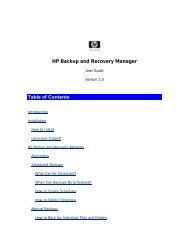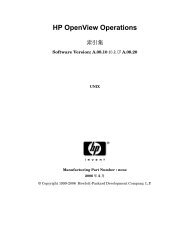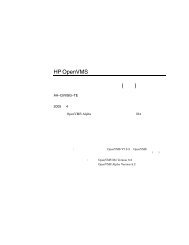HP ProCurve Wireless Access Point 420 - Hewlett Packard
HP ProCurve Wireless Access Point 420 - Hewlett Packard
HP ProCurve Wireless Access Point 420 - Hewlett Packard
You also want an ePaper? Increase the reach of your titles
YUMPU automatically turns print PDFs into web optimized ePapers that Google loves.
Command Line Reference<br />
Interface Commands<br />
6-72<br />
just the unicast keys, but the broadcast keys as well. TKIP is a<br />
replacement for WEP that removes the predictability that intruders<br />
relied on to determine the WEP key.<br />
• AES has been designated by the National Institute of Standards and<br />
Technology as the successor to the Data Encryption Standard (DES)<br />
encryption algorithm, and will be used by the U.S. government for<br />
encrypting all sensitive, nonclassified information. Because of its<br />
strength, and resistance to attack, AES is also being incorporated as<br />
part of the 802.11 standard.<br />
Example<br />
<strong>HP</strong><strong>420</strong>(if-wireless g)#multicast-cipher TKIP<br />
<strong>HP</strong><strong>420</strong>(if-wireless g)#<br />
wpa-clients<br />
This command defines whether Wi-Fi Protected <strong>Access</strong> (WPA) is required or<br />
optionally supported for client stations.<br />
Syntax<br />
wpa-clients <br />
• required - Supports only clients using WPA.<br />
• supported - Support clients with or without WPA.<br />
Default Setting<br />
supported<br />
Command Mode<br />
Interface Configuration (<strong>Wireless</strong>)<br />
Command Usage<br />
Wi-Fi Protected <strong>Access</strong> (WPA) provides improved data encryption, which<br />
was weak in WEP, and user authentication, which was largely missing in<br />
WEP. WPA uses the following security mechanisms.<br />
Enhanced Data Encryption through TKIP<br />
WPA uses Temporal Key Integrity Protocol (TKIP). TKIP provides data<br />
encryption enhancements including per-packet key hashing (i.e.,<br />
changing the encryption key on each packet), a message integrity check,<br />
an extended initialization vector with sequencing rules, and a re-keying<br />
mechanism.

















